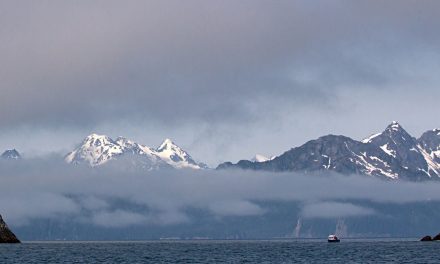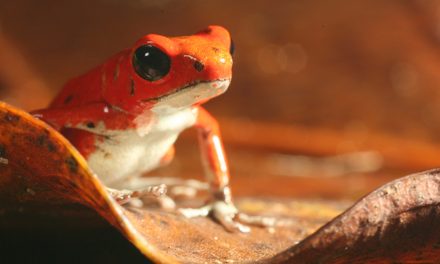
© Vice Pres., Natural Habitat Headquarters Rick Guthke
A successful tourist season at our East Greenland Base Camp was over. With all packed up, we bid goodbye to our wonderful Greenland staff and were ready for the homebound flight after another magic summer season for us and our guests in the high Arctic.
We had a surprise visit in the Kulusuk Airport Hotel. Our local Zodiac driver, Julius, came to send us off after he and a couple of his friends had decided to try their luck and net a few cods in the fjord that same morning. Surprisingly, it had paid off well and this big catch was a welcome source of income for the long winter ahead.
Julius stepped into the foyer with a tired but happy gleam in his eyes, exclaiming “That was amazing—we shoveled the cod out of the water—and tomorrow we are going back to get more! Our nets were heavy—and some of fish were huge!”
Julius was not the only one to observe the bounty of Greenland’s Arctic waters this year. The previous day, on a walk to a promontory overlooking the vast Greenland Sea, our small group of travelers was astounded to observe at least 25 humpback whales spouting and spy-hopping out there in the sunlit waters. I have never seen so many whales in one single spot during my almost 30 years in eastern Greenland!
During the Greenland tourism season, we also experienced magnificent humpback whales right in front of camp and the locals had seen a giant sperm whale venturing close to their settlements—a first.

© David Dea
It finally dawned on me that something fishy is occurring in the waters off East Greenland. Back home, I started researching these matters. I found that international fish researchers have come to the same conclusion: the fish and whale populations are being impacted by the rapidly warming Arctic.
Record-high temperatures have been measured in the ocean currents from fish spawning grounds west of the British Isles to the northeast of Greenland. When mackerel spawn in the spring, they normally follow the Norwegian Current toward the northeast, where they feed during the summer. But since around 2007, large quantities of mackerel suddenly appeared around Iceland in the Irminger Current—the northwestern branch of the Gulf Stream. Year by year, the mackerel have extended their migrations in this new direction, and in 2011, they were caught in Greenland for the first time. The mackerel’s recent arrival has caused problems for the current local fish species when the mackerel eat their food. In other words, higher temperatures in the Arctic can push other cold water species elsewhere, such as the cods that Julius had netted.
Other fish species have followed in the wake of the mackerel. For instance, bluefin tuna have been caught as bycatch in the northern mackerel fisheries, which is amazing, since bluefin tuna are mostly prevalent in temperate and subtropical waters!
I further found that, according to the Environmental Defense Fund and our friends at World Wildlife Fund (WWF), the Arctic will become less productive overall in the long term for several reasons. First of all, most of the newly ice-free waters near Greenland are too deep for some commercially important species like Arctic cod, which will probably seek shallower waters. Furthermore, ocean acidification from carbon dioxide pollution will reduce the productivity of copepods, mollusks, and other shell-making creatures, further changing the Arctic food supply. Finally, warming temperatures might increase the already intense stratification of the Arctic, where warmer water floats on a layer of colder, denser, nutrient-rich water. This may prevent nutrients from the sea floor from reaching the surface and being ingested by the plankton at the base of the food chain.
These are all reasonable concerns, but there may be mitigating factors that could increase the productivity of the Arctic in a warmer world—at least in the short run. For example, deep water will be an obstacle to some species, but not necessarily to all, including some very important commercial species that live mid-way in the water column. Acidification will most likely harm some species in the Arctic food web, but they could be replaced by other species less affected by acidification.

© Natural Habitat Adventures Adventure Director Sara Higgins
Fortunately, this year the United States and four other Arctic nations pledged to prohibit commercial fishing in the international waters of the Arctic Basin until more scientific research can be completed about how warming seas and melting ice are affecting fish stocks.
The agreement came as an annual report on the world’s climate—released by the National Oceanic and Atmospheric Administration and the American Meteorological Society—said that temperatures on the ocean surface reached the highest levels in 135 years of record keeping.
The shrinking levels of sea ice have raised the prospect of industrial-scale fishing in the once-inaccessible Arctic. For the Greenlandic economy, the mackerel might be a welcome visitor at a time when the traditionally important shrimp fishing has been declining due to a diminishing population. Julius had every reason to be happy for the day’s large catch, but it might not be sustainable.
At Natural Habitat Adventures, it is our commitment is to bring our guests in front of some of the Earth’s most magnificent creatures in their natural environments. This includes educating our clients about what is happening to our planet. There is no better place to do that than in East Greenland—the planet’s “canary in the coal mine.” Here, the effects of climate change are truly magnified, impressive and colossal—and we invite you to see it for yourself, close up.
Clearly, big changes are happening right now with our fragile planet. This Greenland fish tale is just one of many.
Stay tuned.



































